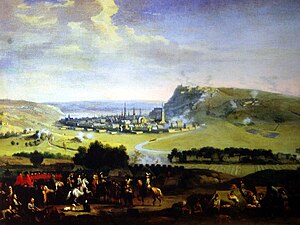1695 Siege of Namur
| Siege of Namur (1695) | |||||||
|---|---|---|---|---|---|---|---|
| Part of the Nine Years' War | |||||||
 Siege of Namur (1695) by Jan van Huchtenburg. In the foreground King William III, dressed in grey, confers with the Elector of Bavaria. |
|||||||
|
|||||||
| Belligerents | |||||||
|
|
|
||||||
| Commanders and leaders | |||||||
|
|
|
||||||
| Strength | |||||||
| 13,000 | 34,000 infantry 24,000 cavalry |
||||||
| Casualties and losses | |||||||
| 8,000 | 12,000 | ||||||
The Siege of Namur, 2 July – 1 September 1695, was the second siege of the city of Namur in the Nine Years' War. The Allied forces of the Grand Alliance retook the city from the French, who had captured it in the first siege in 1692. The recapture of Namur has been called the most important event in the Nine Years' War.
The French captured the city of Namur in the first siege in 1692, under the command of the Duc de Luxembourg, with King Louis XIV of France present. Namur's defensive works had been designed by Menno van Coehoorn, who oversaw the citadel's defence during the first siege. His French counterpart, Vauban improved the defensive works significantly after the city was taken. Given its strategic position at the confluence of the Sambre and Meuse rivers, the Citadel of Namur became the most strategically important fortress in the Spanish Netherlands.
As France was on the defensive, the Allied army of the Grand Alliance under the command of King William III of England (who commandeered the Château de La Falize as his headquarters), and Maximilian II Emanuel of Bavaria, governor of the Spanish Netherlands, laid siege to the city beginning on 2 July 1695. By 3 July, they had invested the city. Menno van Coehoorn, in a reversal of roles, directed the siege works against the city.
...
Wikipedia
